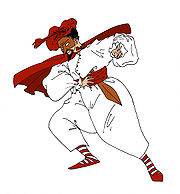
Mezzetino
Encyclopedia

Commedia dell'arte
Commedia dell'arte is a form of theatre characterized by masked "types" which began in Italy in the 16th century, and was responsible for the advent of the actress and improvised performances based on sketches or scenarios. The closest translation of the name is "comedy of craft"; it is shortened...
and is considered by Duchartre to be a variant on the stock character Brighella
Brighella
Brighella is a comic, masked character from the Commedia dell'arte. His early costume consisted of loosely-fitting, white smock and pants with green trim and was often equipped with a battachio or slapstick, or else with a wooden sword. Later he took to wearing a sort of livery with a matching cape...
. His name means "Half-Measure (of liquor)" in Medieval Italian, and he is sometimes called in French and English plays "Mezzetin". He first appeared in the 16th century.

His costume has gone through similar variations to Brighella's, beginning as a baggy white costume like that worn by the zanni
Zanni
Zanni or Zani is a character type of Commedia dell'arte best known as an astute servant and trickster. The Zanni comes from the countryside. The Zanni is known to be a “dispossessed immigrant worker”. "Immigrant" in Italy at the time of the city-states, did not necessarily mean someone from...
but later evolving into a livery
Livery
A livery is a uniform, insignia or symbol adorning, in a non-military context, a person, an object or a vehicle that denotes a relationship between the wearer of the livery and an individual or corporate body. Often, elements of the heraldry relating to the individual or corporate body feature in...
or else a tunic and breeches, usually with stripes, and some sort of hat as an accessory. Whereas Brighella's color is green, Mezzetino's is red or burgundy
Burgundy (color)
Burgundy is a shade of purplish red associated with the Burgundy wine of the same name, which in turn is named after the Burgundy region of France. The color burgundy is similar to other shades of dark red such as maroon...
. He is sometimes played without a mask, especially in later versions, after the manner in which Constantini played him; but when masked it is either brown or rust colored. Callot shows him holding a sword as part of the ensemble. He is also sometimes dressed in a manner that closely resembles the habit of Harlequin
Harlequin
Harlequin or Arlecchino in Italian, Arlequin in French, and Arlequín in Spanish is the most popularly known of the zanni or comic servant characters from the Italian Commedia dell'arte and its descendant, the Harlequinade.-Origins:...
, as in the famous Nymphenburg porcelain, hence some people's belief that he is a variant not on Brighella but on Harlequin. He almost always wears a short cape, called a tabaro, which has its origins in the plays of Ancient Rome
Ancient Rome
Ancient Rome was a thriving civilization that grew on the Italian Peninsula as early as the 8th century BC. Located along the Mediterranean Sea and centered on the city of Rome, it expanded to one of the largest empires in the ancient world....
.
Examples of Mezzetino's character
In one French play[which?], Mezzetin attempts to flirt with the innamorataInnamorati
Gli Innamorati were stock characters within the theatre style known as Commedia dell'arte, which appeared in 16th century Italy. These characters were present within commedia plays for the sole purpose of being in love with one another, and moreover with themselves...
Isabelle. He tells her how in 6 years of marriage, he and his first wife never had one fight until she tried to stop him from sneezing, for which act he murdered her. When Isabelle tries to send him away by pointing out that she is herself already married, he points out that so is he, and that "five sous' worth of rat poison will do the trick" to solve that.

